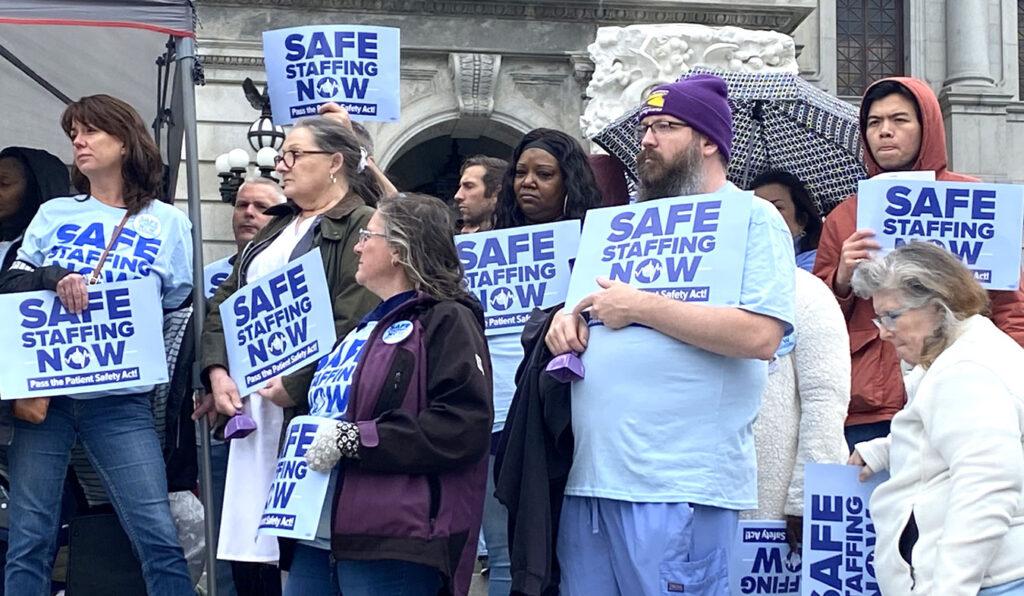
Black Older Adults With Cancer Are Far Less Likely to Get Any Care
New Study From LDI and MD Anderson Finds That Black and Low-Income, Dually Eligible Medicare Patients Are Among the Most Neglected in Cancer Care
News
“Should Hospitals be Required to Have a Certain Number of Nurses?” asks a Philadelphia Inquirer headline about the controversy brewing in Harrisburg around the latest efforts to have the Pennsylvania legislature pass a law requiring minimum patient-to-nurse ratios in its hospitals. It’s the latest general media story that seems to infer that this patient-to-nurse issue is a vague, unsettled thing essentially about a nursing labor grievance. But it isn’t. Hard scientific evidence since the 1980s has shown that having insufficient numbers of nurses on a given hospital unit kills and injures more patients than when there are enough nurses available to adequately attend and monitor those patients. The University of Pennsylvania’s School of Nursing and its Center for Health Outcomes and Policy Research (CHOPR) have played a leading international role in these decades of research.
In recent years, the number of highly trained nurses in hospitals has been affected by severe and repeated budget cuts that save money by increasing the patient-to-nurse ratios so that more patients are assigned to each nurse, and/or by using less trained and skilled aides to replace registered nurses. After California became the first state to enact a minimum required nurse staffing law for its hospitals in 1999, other hospitals and their lobbying organizations across the country worked hard to prevent similar legislation from being enacted in other states–despite the evidence that not having adequate patient-to-nurse ratios leads to higher mortality rates and worse patient outcomes.
The latest effort to enact a minimum required nurse staffing law in Pennsylvania began early in May with the announcement of both House Bill 106 and Senate Bill 240, which together are known as the Pennsylvania Patient Safety Act. Prior to this, similar bills have been introduced every year in the Statehouse since 2010. All have died in Republican-controlled committees.
“It is really an example of how in our democracy a couple of individuals for their own personal reasons can deny legislation that is in the public interest from coming up for a vote,” said Founding Director of CHOPR and LDI Senior Fellow Linda Aiken, PhD, RN.
But now, after last November’s elections, Democrats hold the majority in the Pennsylvania House for the first time in 12 years and this new round of nurse ratio bills is being heavily lobbied by nursing organizations, unions, and public health advocates.
The Pennsylvania Patient Safety Act would set the minimum numbers of patients that could be assigned to individual nurses in a hospital’s various departments. Those ratios vary depending upon the nature of the unit’s focus and severity of patients’ conditions and treatment. (See the list of the exact ratios the Act specifies for various hospital units.)
It isn’t all that difficult to understand why patient-to-nurse ratios matter if you think of the times you yourself have been in a hospital bed. Nurses function as your minute-to-minute biomedical and wellbeing surveillance system. Although they may appear to be just taking your temperature, providing scheduled pills, or checking your IV set up, they are doing much more invisibly — for every patient under their care.
The wide variety of conditions and illnesses treated in hospitals are all prone to various sorts of disastrous, and often unexpected complications that, if not recognized and immediately addressed, can lead to increased patient deaths, injury, or permanent disability. Together across a ward or unit, nurses function as a critical surveillance system constantly monitoring each patient for the subtle signs that something in their condition has or is about to change for the worse. This invisible surveillance system by highly trained and experienced registered nurses is the most critical–but least understood–of the services they provide.
But the intensity and effectiveness of that surveillance is determined by how many patients a single nurse is charged with caring for. For instance, a registered nurse caring for four seriously ill patients on a shift can conduct a far more comprehensive surveillance on each than if caring 10 or more seriously ill patients on a shift. Research has shown that each additional patient assigned to a registered nurse beyond the optimum ratio significantly increases the risk of preventable death, longer stays, readmissions, and unfavorable patient satisfaction. It directly results in less effective care, poorer patient outcomes, and higher costs of care.
In her testimony earlier this month as lead witness before the Pennsylvania House Health Committee hearing on the Patient Safety Act, Aiken detailed the findings of CHOPR’s recent study of patient-to-nurse variations and health outcomes in 114 Pennsylvania hospitals. Conducted according to a National Institutes of Health-funded research protocol, the project used data from more than half a million patients.
In adult medical and surgical units in the 114 hospitals, researchers found patient-to-nurse ratios variations from 3-11. “This is huge variation in a hospital resource that has been shown in hundreds of studies to be associated with a wide range of patient outcomes including mortality, failure to rescue patients with complications, hospital acquired infections, patient satisfaction, length of stay, readmissions, and patient safety,” they noted.
Further analyzing 33 different aspects of patient severity of illness and hospital organizational characteristics, the researchers determined that “in-hospital mortality increased by 7% for each additional medical patient and 8% for each surgical patient added to nurses’ workloads.” They also found that hospital readmissions increased by 2% for medical patients and 4% for surgical patients for each 1 patient increase in nurses’ patient workloads.”
The researchers estimated that if the Patient Safety Act was passed and implemented it would:
Aiken also provided evidence in the hearing that Pennsylvania has a sufficiently large supply of nurses to meet the standards set by House Bill 106. She said Pennsylvania has a larger supply of nurses per 1,000 residents than all but five other states and Washington, D.C., and a significantly larger supply of nurses than California which has had mandated minimum hospital nurse staffing for 20 years.
“The root cause of nurse burnout and turnover is impossible and dangerous workloads and setting a safe nurse staffing level will bring more nurses back to the hospital bedside,” said Aiken.
“The common finding in all our policy outcomes research on nurse staffing,” said Aiken, “is that there is significant variation across hospitals in nurse staffing adequacy with substantial adverse outcomes for the public and that establishing mandated minimum safe hospital nurse staffing standards saves lives and money. Further delays in mandating safe nurse staffing in hospitals are not in the public’s interest and elected officials should act now on the basis of the evidence.”



New Study From LDI and MD Anderson Finds That Black and Low-Income, Dually Eligible Medicare Patients Are Among the Most Neglected in Cancer Care

Her Transitional Care Model Shows How Nurse-Led Care Can Keep Older Adults Out of the Hospital and Change Care Worldwide

Chart of the Day: Medicare-Medicaid Plans—Created to Streamline Care for Dually Eligible Individuals—Failed to Increase Medicaid Participation in High-Poverty Communities

Penn LDI Debates the Pros and Cons of Payment Reform

Direct-to-Consumer Alzheimer’s Tests Risk False Positives, Privacy Breaches, and Discrimination, LDI Fellow Warns, While Lacking Strong Accuracy and Much More

One of the Authors, Penn’s Kevin B. Johnson, Explains the Principles It Sets Out